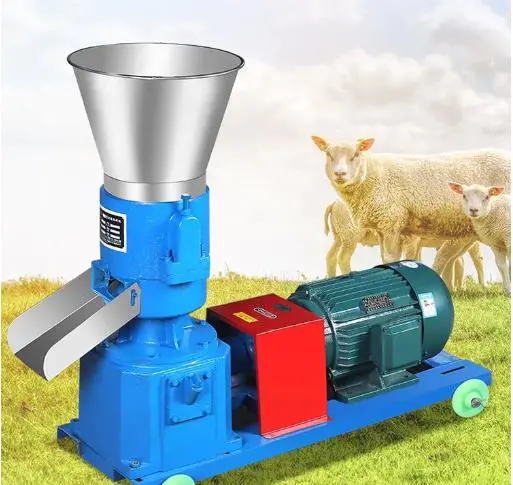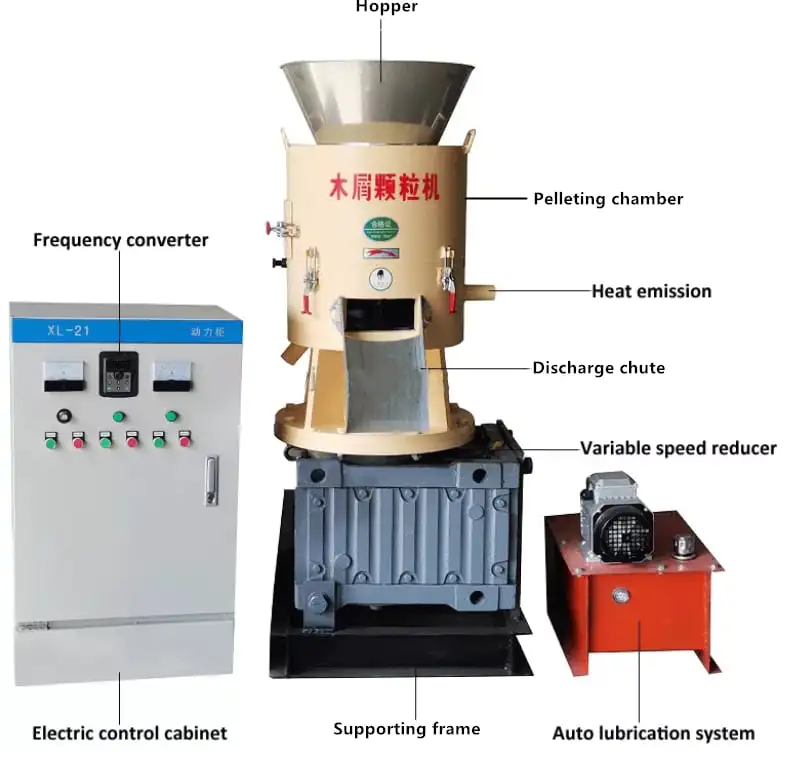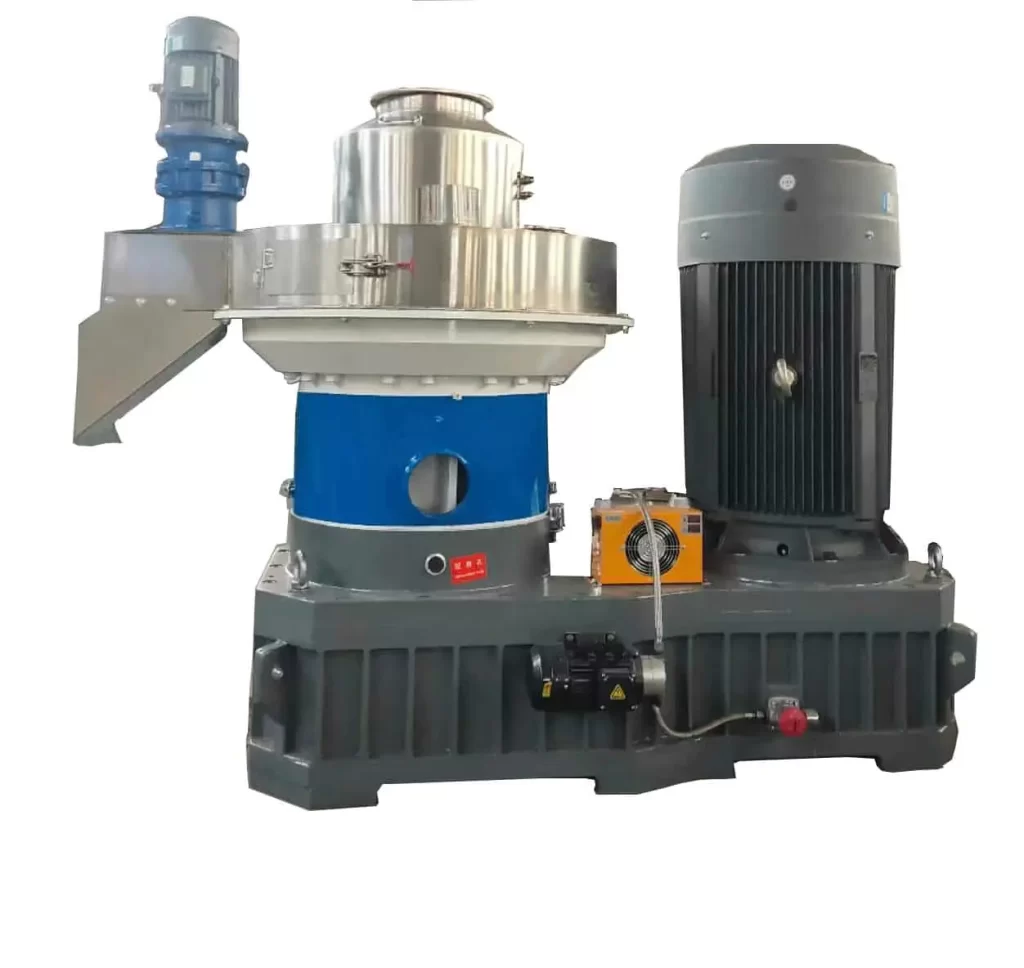
You can get a animal feed pellet mill anywhere in the world. It’s also called a pellet feed mill machine or a pellet mill for feed.
Biomass will keep getting better in the future. The feed pellet machine also gives you the chance to start your own business. The machine is becoming more and more important to our lives and businesses. Let us discuss more about how a feed pellet mill works and its basic parts.
What Is a Animal Feed Pellet Mill?
There are a few different names for the feed pellet machine, including a pellet feed mill and a fodder pellet mill. It is a piece of machinery that is used for the preparation of animal feed and has the capability to directly extrude maize, soybean meal, rice husk, straw, and grass into pellets of a smaller size.
Feed pellet mills are divided into two types. Each has its own structure and working principle. The two common types of pellet mill are:
- Flat Die Mill
- Ring Die Mill
Parts of a Flat Die Pellet Mill

There are three major parts to a flat die pellet mill: the part that makes pellets, the drive engine, and the drive system. A flat die pellet mill is made up of a feed hopper, an upper box body, an adjusting nut, a pellet outlet, a spindle box, a gearbox, a transmission shaft, a base, wheels, an electric motor, and an electric control cabinet.
Parts of a Ring Die Pellet Mill

A ring die pellet mill has several important parts that work together to turn raw materials into pellets that are crushed. The ring die, rollers, hopper, conditioner, and gearbox are some of the most important parts. The ring die is very important because it has holes in it that push the raw material to form the pellets.
Rollers push down on the material by being positioned against the ring die. Providing a steady Pelletization process, the feeder controls the steady flow of raw materials. The conditioner sets the right amount of wetness and temperature so that pellets can form properly. Lastly, the gearbox runs the whole system by sending power from the motor to the rollers and ring die.
Brief Intro to Operations of Animal Feed Pellet Mill
The primary objective of this operation is to transform mash feed into pellet form by combining it with steam. The digestibility of feed is enhanced through pelleting, resulting in improved performance with better quality pellets.
The pellet mill section includes various components such as the feeder, conditioner, pellet mill, pellet cooler, elevator, pellet sieve, pellet cooler cyclone, blower, and air lock. The molassed feed is transferred from the storage bin to the feeder and then to the conditioner.
In the conditioner, dry saturated steam is added to the feed and it is then fed to the pellet mill at a controlled rate. Let us discuss the functioning of a feed pellet mill in detail.
1. Preparation of Raw Material
The journey of feed pellet production begins by preparation of raw material. The raw material used to make high quality pellets are grains like like corn, wheat, or barley. You can also use protein sources such as soybean meal or fish meal, vitamins, minerals, and other additives.
The machine converts these raw materials into fine powder using a crusher. Crushing helps make the palletizing process easier and increases production capacity and production rate. Pellet machines provided by Lemonmach have great crushers that convert biomass materials into powder of uniform consistency.
2. Conditioning
The second step of functioning is conditioning. It works by optimizing the moisture content and the temperature. Good moisture and temperature makes the working more effective.
Steam is introduced from one side of the machine. It increases the moisture of the raw material. The mixture mixes the powder to make it of uniform consistency. An efficient conditioning process makes the binding properties and quality of the pellets better.
3. Pelletization
The material that has been prepared is put into the pellet mill. A feed pellet mill is made up of two main parts: a die and rollers.
The die is a metal plate with holes in it that are all the same size. The rollers press against the die to push the material through the many holes. The material is heated and pressed as it moves through the die, making dense pieces.
4. Die and Roller Design
The design of the die and roller is very important in deciding how the pellets will look, how big they will be, and how dense they will be. You can use different dies to make pellets in different sizes and shapes. This is done to meet the specific nutritional needs of the animals.
5. Cooling
Once the pellets have been pelletized, it is necessary to cool them before proceeding with any additional processing or packaging. Cooling is usually achieved by using a counter flow cooler. In this process, ambient air is pushed against the hot pellets to lower their temperature. This helps lower their temperature and makes them stronger.
6. Screening and Grading
The pellets that have been cooled might be screened to get rid of any small particles or fines that don’t meet the required size. This makes sure that the end result is consistent and meets high quality standards.
7. Packaging of Feed Pellet
The last step is to package the pellets so they can be distributed. Feed pellets are commonly packaged in bags or bulk containers for easy transportation to farms, feed stores, or other users. Packaging often includes labels that provide nutritional information and instructions for how to use the product.
Conclusion
Pellet fuel is an excellent option for providing nourishment to a wide range of animals, effectively meeting their dietary requirements. The process is straightforward and the methods are highly advantageous. Avoid spending money on regular food purchases for your animals or pets.
Discover resources that remain abundant, even without occupying additional space. Why not reach out to suppliers at Lemonmach and explore the possibility of acquiring your very own pellet mill for producing feed and biomass pellets?
